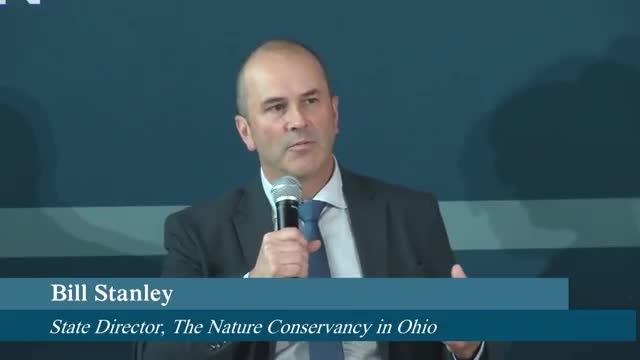Nature-based wetlands restoration highlighted as efficient way to reduce nutrient loads
October 15, 2025 | Columbus City Council, Columbus, Franklin County, Ohio
This article was created by AI summarizing key points discussed. AI makes mistakes, so for full details and context, please refer to the video of the full meeting. Please report any errors so we can fix them. Report an error »

Panelists at a Columbus Metropolitan Club forum said restoring and protecting wetlands is an important complement to farm practices and sewer upgrades in reducing nutrient pollution.
"Think about wetlands like kidneys. They clean water," Bill Stanley, State Director of The Nature Conservancy in Ohio, said. Stanley said wetlands can capture nutrients from a range of sources — farm runoff, failing septic systems, and combined sewer overflows — and that restored wetlands add biodiversity and recreation benefits in addition to water-quality gains.
Stanley described early economic findings from a Nature Conservancy study of H2Ohio wetland investments: "For every $1 of investment from H2Ohio that's gone into wetlands, $8 is returned in terms of benefit to people in Ohio." The study was described as near completion at the time of the forum.
Panelists urged that wetland restoration be considered alongside precision agriculture and infrastructure investment because wetlands can treat nutrient loads regardless of their source, and because they provide co-benefits for wildlife and recreation.
Speakers said natural infrastructure should be part of a balanced portfolio of investments, and that continued funding is necessary to scale wetland restoration to a level that meaningfully reduces downstream harmful algal blooms.
"Think about wetlands like kidneys. They clean water," Bill Stanley, State Director of The Nature Conservancy in Ohio, said. Stanley said wetlands can capture nutrients from a range of sources — farm runoff, failing septic systems, and combined sewer overflows — and that restored wetlands add biodiversity and recreation benefits in addition to water-quality gains.
Stanley described early economic findings from a Nature Conservancy study of H2Ohio wetland investments: "For every $1 of investment from H2Ohio that's gone into wetlands, $8 is returned in terms of benefit to people in Ohio." The study was described as near completion at the time of the forum.
Panelists urged that wetland restoration be considered alongside precision agriculture and infrastructure investment because wetlands can treat nutrient loads regardless of their source, and because they provide co-benefits for wildlife and recreation.
Speakers said natural infrastructure should be part of a balanced portfolio of investments, and that continued funding is necessary to scale wetland restoration to a level that meaningfully reduces downstream harmful algal blooms.
View full meeting
This article is based on a recent meeting—watch the full video and explore the complete transcript for deeper insights into the discussion.
View full meeting
